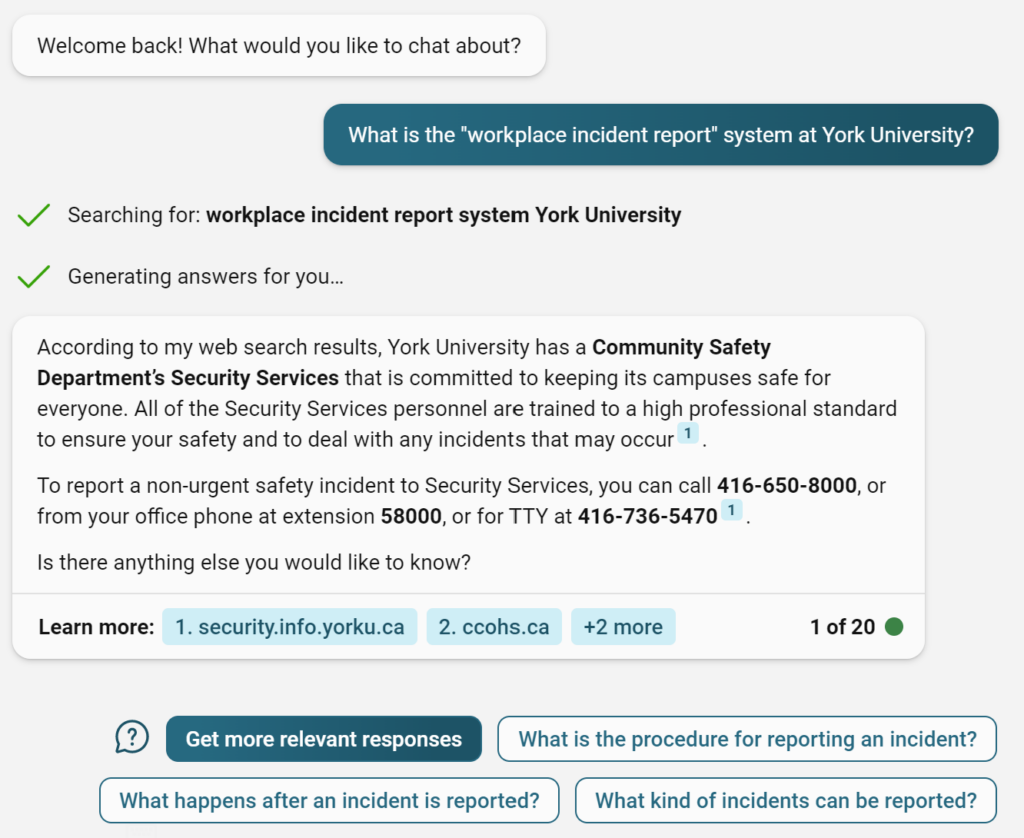Update! (Nov 30, 2023)
It appears that the Workplace Incident Report (WIR) form is back to being hidden behind the PPY authentication wall.
These are not state secrets. It is a document related to health and safety and workers have the right to access them without having to jump through authentication hoops that hinder workers and block search engine tools.
Update! (August 28, 2023)
The issue of password-protecting the Workplace Incident Report (WIR) form appears to have been resolved. I raised the issue at the May and August HSEC meetings and, now, the WIR form is available out in the public. This will make it more useful for community members to use to report health and safety incidents. The WIR is linked to from this general page and can be found directly here: WIR Form.
Note: don't assume that your WIR submission has been dealt with. Copy your JHSC (Joint Health and Safety Committee) on WIR submission. Please follow-up with Employee Well-Being's "WIR" email account and escalate as need to EWB ( ewb@yorku.ca ) as there have been documented issues in the past with data tracking and analysis (as minuted at HSEC). If you fail to obtain resolution, follow-up with your local Joint Health and Safety Committee.
Below you will find a copy of the 2019 version of the Workplace Incident Report form. This is the only copy outside of the two-factor-authentication wall at York University. Fill it out with your work unit manager and have your manager email it to wir@yorku.ca.
Why This Blog Post?
Why this blog post? Because I've, once again, hit a brick wall with our internal bureaucracy here at York. When I raised my concern at the HSEC about the lack of clarity and accessibility with respect to the WIR system I got the tut, tut, don't worry about it but to placate you we'll look into it brushoff. The kind of brushoff women often get at the car mechanic.
These kinds of brushoffs have become commonplace during the pandemic. Managers and their staffers have gotten quite adept at them.
So here, publicly, I'm going to explain the concern and what needs to happen next. This issue has persisted for four years and unless someone makes a stink about it, the current system will remain in place and injuries will go unreported. And that's not acceptable.
The Incident Reporting System Is Hidden
I represent the York's faculty association, YUFA, on York University's Health and Safety Executive Council. In this position I get to hear about and discuss matters of health and safety that affect and involve York University community members, including employees and students. One of my take-aways from these meetings is that, while there are plenty of well-meaning and skilled members of our community who say that they are concerned about health and safety at the University, that concern and skill is hindered by a bureaucracy and communication system that isn't terribly efficient nor is it as effective as it could be.
The Workplace Incident Report (WIR) is a very good example of this.
For months now, in meetings at both the HSEC and the Joint Health and Safety Committee that I also sit on, I've heard from employees that there is a "wire" system for reporting incidents. And by incidents, we mean, accidents and events where people get hurt, like a "trip and fall", machine tool accident, etc.
Now, I've only been at the HSEC and the JHSC since mid-2022 and figured that this whole "wire" thing (that's how it's pronounced) was some well-known thing. But it's not. So, in yesterday's HSEC meeting, I asked for clarification about how to submit these reports, and was told that it's a PDF form -- and then discovered that the WIR form is hidden behind the two-factor-authentication system webpage at York. The web address is literally:
https://yulink-new.yorku.ca/documents/872311/0/Workplace+Incident+Report+(WIR)+-+July+2019.pdf/85f23d92-5aff-4f7d-ab33-c467c4ec3a38Obvious, right?
Worse, it's hidden behind the two-factor-authentication system at York, so if someone's been hurt and you need to report it but are confused about how, you have to find your 2FA app or dongle to validate your identity before proceeding. Don't have the app or the dongle? Too bad.
Now, I'm sure that there are going to be some people out there that are going to say "Oh, it's just Professor Smith being dramatic again and looking to stir up trouble." I've always been that nerdy, uncool kid and decades of eye-rolls play on your self esteem, so I did what any nerdy, uncool kid does when they need to get some validation.
I asked ChatGPT about WIR.

But Google and I go way back and I didn't want Google to feel left out, so I asked Google, too.
It's clear that neither Google nor ChatGPT can dig up much on the reporting system.
But, surely, our internal email system would know the account, right? Not quite. While Outlook recognizes the email address, it provides no details about what the account is for, so an employee who has never reported via WIR might stumble at this stage and look for an alternative, not wanted to email the wrong person details that could be personal and private.
And if those two workhorses of knowledge can't find it, what chance is there that a new department chair or research assistant working in a lab in the basement of the Science building with rashy hands is going to find that form?
First Thing That Needs to Happen
The Workplace Incident Report system needs to have a public entry point that is free of passwords and authentication requirements. Period. Full stop.
As soon as an employee in our HSEWB department, or their supervisor or someone with qualifications in media and communications does the right thing and posts the WIR form in a public, non-2FA-protected page in a manner that allows for it to be easily found as a top hit on Google, Bing, Duck-duck-go and any of the new-fangled chatbots, I'll update this post to point to that form. But until that happens, this post is set up to help employees do the right thing and submit workplace incident reports in a timely and effective manner.
Second Thing That Needs to Happen
We need a "X Days Since Accident" type signage. Currently, tabulated lists of incidents like assaults and "trip and falls" are provided to the Health and Safety Executive Council, but they are not more widely distributed. This needs to change. Community members need to know that these kinds of incidents happen. Keeping quiet about it is unhelpful.
Incident data needs to be gathered in a transparent, verifiable manner. It needs to be disclosed in a clear and public forum. All of this can be done in a manner that respects and values the privacy of those involved. Stating that there were "5 assaults in the vicinity of XYZ building" or "10 trip-and-falls in front of ABC Pavilion" does not violate the privacy of those involved.
We have a problem here with sloppy record keeping and reporting. I've personally reported on this issue twice to the HSEC in the past 8 months. It was also highlighted in a complaint at the HSEC. It's a known, recurring problem. It needs to be fixed. And making anonymized data reports public is an important step in that direction.
A Note about ChatGPT
I'm aware of the problems with trusting AI chatbots like ChatGPT. I work in an engineering and computer science school and pay attention to my colleagues who are world class experts in this and related fields. While chatbots provide answers with authoritative tone, their output is notoriously flawed, often containing factual errors and biases inherent in the training dataset. The reason I used it is because, in spite of these flaws, we are very likely to see University employees and students use chatbots to find out how to report injuries. I'm certain that the reason that the chatbot (or Google's standard search engine) couldn't find actionable information on WIR is because the incorrect decision was made to hide the WIR form behind a two factor authentication system.
Edits:
August, 2023: Update to reflect a change to the WIR status. I thought that, in testing, that it was public at that time. I may have been wrong and that my authentication status was simply active when I ran the test. Regardless, see note for November 2023.
November 30, 2023: I fixed a typo ("indicent" to "incident"). Also, a note added that the WIR appears to be behind the authentication wall again, including the general access page. Removed some "XXXX" placeholders for dates that aren't necessary. Added my bio at the bottom.

James Andrew Smith is a Professional Engineer and Associate Professor in the Electrical Engineering and Computer Science Department of York University's Lassonde School, with degrees in Electrical and Mechanical Engineering from the University of Alberta and McGill University. Previously a program director in biomedical engineering, his research background spans robotics, locomotion, human birth and engineering education. While on sabbatical in 2018-19 with his wife and kids he lived in Strasbourg, France and he taught at the INSA Strasbourg and Hochschule Karlsruhe and wrote about his personal and professional perspectives. James is a proponent of using social media to advocate for justice, equity, diversity and inclusion as well as evidence-based applications of research in the public sphere. You can find him on Twitter. Originally from Québec City, he now lives in Toronto, Canada.
